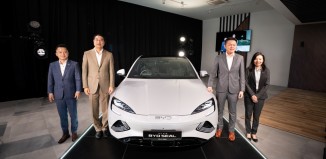WiLL-Vi – A Different Kind of Toyota
The WiLL-Vi (which went on sale in January 2000 in Japan) is a 4-door compact runabout which uses the same platform as the Toyota Yaris/Vitz. Its distinctive yet simple styling combines a modernity with several nostalgic features.
The initiative to create such a model began in 1997 when Hiroshi Okuda, then the President of Toyota Motor Corporation, established a venture start-up within the company to develop and market new vehicle concepts aimed at the Japanese youth market – specifically the ‘Dankai Jr.’ Generation which is made up of young consumers in their 20s and 30s who are ‘extremely difficult’ and ‘particular’ about many things in life. Their criterion in deciding on something is usually ‘Will it please me?’, hence the brand name of ‘WiLL’.
This ‘firm within a firm’ took a radically different approach. In addition to developing its own sales and distribution channels separate from the Toyota dealer network, the Virtual Venture Company (VVC), as it is called, teamed up with several other major Japanese manufacturers to create the new consumer lifestyle concept and brand. The goal was not to have specific brand names appear but to highlight the brand name on products that would appeal to the targeted consumers. Ultimately, with the brand drawing consumers, there would be a ‘mushroom effect’ which would benefit all the participants.
MULTI-INDUSTRY PARTICIPANTS
In August 1999, Toyota and a number of other major Japanese manufacturers – all from different sectors of industry – agreed to cooperate on a joint consumer lifestyle marketing project in Japan. Designed to generate radically fresh ideas and develop novel sales, marketing and distribution methods, this project centred around the ‘WiLL’ concept. Under this concept, each manufacturer would develop and market a series of products, the common theme being that they should all resonate with modern Japanese youth consumer lifestyles. In specific terms, products should appeal to the young spirit with its love of fun and desire for the real thing.
WiLL-branded products include a computer, microwave oven and refrigerator specially developed by Matsushita Electric and a new beer from Asahi Breweries. Kao, the cosmetics company, also offers a WiLL deodorizing spray claimed to kill cigarette smoke, while a leading travel agency has created a range of customized tours oriented towards younger Japanese who prefer the less rigid programs which older Japanese typically appreciate when travelling.
INDIVIDUALITY IN DESIGN
VVC developed the WiLL-Vi based on this philosophy. The WiLL-Vi is an example of VVC’s insistence on creating a vehicle feel in line with the WiLL concept. Once the results of the consumer design testing had established which steering wheels, external designs, internal fittings, and alternative colour schemes potential users preferred, no compromises were made on the quality.
By focussing on the owner and exuding a strong sense of stylish individuality, the WiLL-Vi’s design in intended to appeal to those who are confident about who they are and what they like. Compact, yet spacious enough inside to accommodate up to five people, its interior has been designed to be relaxing for just the driver alone or a whole group of occupants.
SIMPLICITY IS THE THEME
The car’s design was guided by a “Simplicity is Beauty” philosophy, and Toyota’s designers and engineers adhered closely to this in their approach. Rather than create a large number of possible variations and options, they set out determinedly to make the WiLL-Vi a single unisex package, by applying the principle of keeping what was good and eliminating anything extraneous from the design.
“Everything a driver would want is already standard,” explained Jun Yasumatsu, who led the development team. “The beauty of the vehicle is in its simplicity.” In fact, the only available options are for the audio system or the roof-type (conventional hardtop or canvas convertible).
PLAYING THE ANGLES
Several elements stand out within the overall body design. First, compared with the smooth monoform bodies of most modern vehicles, the WiLL-Vi is a three-dimensional wonder. It almost looks like it has been teleported in from a past age when cars were a group of molded plates bolted together. Formed by the piecing together of several planes to create expressive angles, the vehicle’s exterior has a solid, relief-like feel.
The most striking aspect of the exterior design is the rear passenger door, which forms an acute angle with the roof. The wrap-around rear doors, hidden C-pillar and distinctive cut-in effect created by this design are what give the car its appearance of a carriage.
The carriage motif extends to the four corners of the vehicle as well. The wheels, placed as close to the vehicle’s corners as possible, combined with the prominent blister fenders, emphasize the vehicle’s stability and create an aura of solidity.
HITTING A FUNKY GROOVE
To add yet another dimension to the exterior’s distinct planes, sets of parallel grooves were embossed on the side panels, front hood and bootlid. The hubcaps, steering wheel and instrument panel continue the motif, adding to the vehicle’s overall funkiness.
While indisputably funky, the WiLL-Vi still manages to embrace the ideals of symmetry and simplicity throughout. The car’s front face and rear face, for example, are nearly identical. The interior is purposely plain and symmetrical. This sparseness is also somewhat reminiscent of vehicles at the turn of the century. The externally-hinged boot, for example, subtly compliments the car’s simple retro feel.
HANGING’ OUT ON THE SOFA
The emphasis in the interior design of the WiLL-Vi was very much on choosing materials that would be reassuring to the touch. Overall, the designers sought to create a calming, friendly, graceful atmosphere for the interior that anybody riding in the car would find instantly relaxing. The interior colour choices reflect this philosophy completely; various earth tones help to create a comfortable, natural ambience.
Much like you would never place furniture wall-to-wall in your home, the designers of WiLL-Vi wanted to balance the car’s “furniture” (its instrument panel, seats, trim, etc) with its “walls” (the cabin sides). For this reason, rather than feeling encapsulated by a conventional interior, the occupants feel as if they are hanging out in their home – or maybe even as if wearing a favourite jacket.
The optional canvas roof is designed to appeal to those with a love of freedom and old-style, simple technology. Manually operated, it folds up and back. The space above the car thus created is expansive, substantially enhancing the sense of personal freedom.
A ZIPPY POWERTRAIN
The WiLL-Vi’s 1.3-litre 2NZ-FE engine (same power unit as in the Yaris/Vitz) has an all-aluminium cylinder block and plastic intake manifold to keep the weight down. A VVT-i (Toyota’s variable valve timing mechanism) system on the intake side increases fuel economy. In addition, a number of other features, such as an offset crankshaft, have been added to boost fuel economy. An aluminium oil pan with improved sealing characteristics reduces noise and vibration. The 1,290 kg WiLL-Vi also boasts one of the world’s lightest automatic transmissions operated by a column-shift gearlever.
Uncertain of how the WiLL-Vi would be received outside Japan, Toyota has not made plans to export the ¥1.3 million (about RM45,500 before tax) car which has been selling well in the domestic market.
























